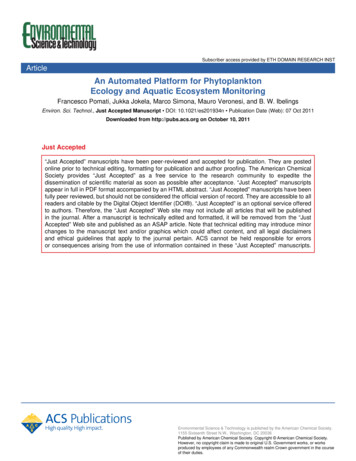
Transcription
Speaker BiosketchesRodolphe Barrangou, PhDDepartment of Food, Bioprocessing and Nutrition Sciences,College of Agriculture and Life Sciences, North Carolina State UniversityRodolphe Barrangou is an Associate Professor in the Department of Food, Bioprocessing and NutritionSciences at North Carolina State University, focusing on the molecular biology of CRISPR-Cas immunesystems, and their exploitation for genotyping, building immunity against exogenous elements and to editthe genomes of industrially relevant organisms. Initial work in the industry, at DuPont, focused onfunctional genomic analyses of bacteria involved in biomanufacturing and food fermentation processes,with emphasis on the genetic basis of dairy product fermentation using starter cultures, and on themolecular basis of health-promoting probiotic bacteria. Recent work is focused on harnessing thepotential of CRISPR-Cas systems for functional genomic studies and engineering of industrial bacteria.
Maria Bondesson, PhDCenter for Nuclear Receptors and Cell Signaling,University of HoustonMaria Bondesson is a Research Assistant Professor at the Center for Nuclear Receptors and CellSignaling at the University of Houston, Houston, TX. Dr. Bondesson has a PhD in virology from theDepartment of Cell and Molecular Biology at Karolinska Institutet, Stockholm, Sweden. After thecompletion of her thesis, she did a first postdoc on mapping of genetic alterations in brain tumors(glioblastoma) at the Ludwig Institute for Cancer Research, Stockholm, Sweden, and a second one onthyroid hormone receptors at Karolinska Institutet. In 1998 she became a research group leader atKarolinska Institutet, working on transcriptional regulation by thyroid hormone. In 2004, Dr. Bondessonwas recruited to the Department of Biosciences at Karolinska Institutet to work as a Project Manager forthe European Commission-funded CASCADE Network of Excellence, a research project on chemicalcontaminants in food. In 2009, Dr. Bondesson moved to the University of Houston and worked as aProject Manager and researcher for the EPA-funded Texas–Indiana Virtual STAR Center, focusing ondevelopmental toxicity in zebrafish and stem cells. Dr. Bondesson’s recent research activities includedevelopment of screening models based on zebrafish for endocrine disruption, vascular disruption andneurotoxicity. She has also used zebrafish to screen for obesogens and diabetogens.Recent publications:Shirinifard A, McCollum CW, Bondesson M, Gustafsson J-Å, Glazier JA, Clendenon SG. 3D quantitativeanalyses of angiogenic sprout growth dynamics. Developmental Dynamics 2013 242(5):518–26Ducharme NA, Peterson LE, Reif D, Benfenati E, McCollum CW, Gustafsson J-Å, Bondesson M. Metaanalysis of toxicity and teratogenicity of 133 chemicals from zebrafish developmental toxicity studies.Reproductive Toxicology 2013 41:98–108Hao R, Bondesson M, Singh AV, Riu A, McCollum CW, Knudsen TB, Gorelick DA, Gustafsson J-Å.Identification of estrogen target genes during zebrafish embryonic development through transcriptomicanalysis. PLoS ONE 2013 8(11): e79020Katchy A, Pinto C, Jonsson P, Vu T, Pandelova M, Schramm K-W, Gustafsson J-Å, Bondesson M,Williams C. Co-exposure to phytoestrogens and bisphenol A mimic estrogenic effects in a additivemanner. Toxicological Sciences 2014 138(1):21-35.Riu A, McCollum CW, Pinto C, Grimaldi M, Hillenweck A, Perdu E, Zalko D, Bernard L, Laudet V,Balaguer P, Bondesson M, Gustafsson J-Å. Halogenated Bisphenol A analogs act as obesogens inzebrafish larvae (Danio rerio). 2014 Toxicological Sciences 2014 Mar 3. [Epub ahead of print]
Jeff Bronstein, MD, PhDDepartment of Neurology, School of Medicine, University of California Los AngelesMolecular Toxicology Interdisciplinary Program, University of California Los AngelesJeff Bronstein is a movement disorders neurologist and a basic scientist. His research involves thedevelopment of cell and zebrafish models to study the causes of Parkinson’s disease and to develop noveltherapies. Dr. Bronstein earned his bachelor's degree from the University of California Berkeley and hisMD and PhD degree in neuroscience from the University of California Los Angeles. Since 1991, he hasbeen Director of the UCLA Movement Disorders Program. Recent publications have focused on the rolesof pesticide exposure and human genetic variants in the development of Parkinson's disease.Dr. Bronstein has served on a number of study sections for the National Institutes of Health and theNational Institute of Environmental Health Sciences. His professional memberships include the AmericanNeurological Association, Movement Disorders Society, and the American Academy of Neurology; hecurrently serves on the editorial board of Neurology Research International. Honors include the S. WeirMitchell Award from the American Academy of Neurology and the UCLA Neurology Golden HammerTeaching Award.
Shawn Burgess, PhDDevelopmental Genomics Branch, National Human Genome Research Institute,U.S. National Institutes of HealthShawn Burgess received his PhD in Genetics from the Johns Hopkins University School of Medicine,where he studied the genetics of mitochondrial fusion and fission in yeast. He trained with Dr. NancyHopkins at Massachusetts Institute of Technology where he was part of a large effort to developinsertional mutagenesis in zebrafish coupled with a genetic screen to identify genes essential for earlydevelopment of a vertebrate. Since 2001, Dr. Burgess has been at the National Human Genome ResearchInstitute, where he is now a Senior Investigator running the Developmental Genomics Branch. Much ofDr. Burgess’ work in the last decade has been focused on developing efficient gene knockouttechnologies in zebrafish coupled with efficient phenotyping of the gene disruptions.
Michael J. Carvan III, PhDSchool of Freshwater Sciences, University of Wisconsin MilwaukeeMichael Carvan is a Shaw Associate Professor at the University of Wisconsin Milwaukee School ofFreshwater Sciences, where he conducts research that is focused on gene environment interactions andidentifying genes that influence sensitivity and resistance to environmental chemicals, especially thosethat cause birth defects or developmental problems. Dr. Carvan received his PhD in Toxicology from TheTexas A&M University, received postdoctoral training in the Center for Environmental Genetics at theUniversity of Cincinnati Medical Center, and was on the faculty in the University of Cincinnati MedicalCenter Department of Environmental Health prior to moving to UW Milwaukee. Dr. Carvan has wellover 40 peer-reviewed scientific publications and serves on the editorial board for four scientific journals.He routinely reviews grant applications for the U.S. National Research Council, National Institutes ofHealth, and National Science Foundation, as well as similar organizations in other countries. He serves ona number of professional committees including the United States Army Medical Research Institute ofChemical Defense Steering Committee for Environmental Health Risk Assessment Methods and theInstitute of Medicine Committee for Review of the Health Effects in Vietnam Veterans of Exposure toHerbicides. Current work focuses on the effects of developmental methylmercury exposure, includingtransgenerational phenotypes, which are likely the result of heritable DNA methylation epimutations.
Warren Casey, PhD, DABTNational Institute of Environmental Health Sciences,U.S. National Institutes of HealthWarren Casey is Director of the U.S. National Toxicology Program's Interagency Center for theEvaluation of Alternative Toxicological Methods (NICEATM) at the National Institute of EnvironmentalHealth Sciences. He received his undergraduate degree in biochemistry and his PhD in microbiology fromNorth Carolina State University (NCSU). Dr. Casey also serves as an Adjunct Associate Professor in theDepartment of Microbiology at NCSU and is a Diplomate of the American Board of Toxicology.Prior to joining NICEATM, Dr. Casey was the Manager of Pharmaceutical Microbiology at Glaxo Inc.from 1994 to 1999; Head of Biomarker Development at GlaxoWellcome, Inc., from 1999 to 2002; and aSenior Scientist in Discovery and Investigative Toxicology at GlaxoSmithKline, Inc., from 2002 to 2009.
Keith Cheng, MD, PhDDepartment of Pathology, College of Medicine, Penn State UniversityKeith Cheng received his BA from Harvard University in biochemical sciences in 1976 and his MD fromNew York University in 1980. He obtained his PhD in molecular genetics at the Fred Hutchinson CancerResearch Institute and University of Washington in 1987 during his residency in anatomical pathology(begun at Brigham & Women’s Hospital and completed at University of Washington Hospitals). He isboarded in anatomic pathology.Dr. Cheng is a member of the Jake Gittlen Cancer Research Foundation, Distinguished Professor ofPathology and Director of Experimental Pathology at Penn State College of Medicine with jointappointments in the Department of Biochemistry and Molecular Biology and the Department ofPharmacology. He was founding co-director of the Penn State bioinformatics and genomics graduateprogram, and is director of the Penn State Zebrafish Functional Genomics Core and member of the PennState Institute for Personalized Medicine.Dr. Cheng was among the first to use the zebrafish to study the genetics of cancer. He led a team thatdiscovered the key role of SLC24A5, the human orthologue of the zebrafish golden gene, in the evolutionof skin color in people of European ancestry. He was awarded the 2008 Penn State Scholar Medal in theBiological Sciences for this discovery and its use to demystify race and skin color. He is now working toidentify polymorphisms responsible for the lighter skin of East Asians. Dr. Cheng also created a virtualatlas of zebrafish microanatomy (zfatlas.psu.edu), and for the past 5 years has been working to create a3D version of histology using microCT. He believes that accomplishing this goal has the potential torevolutionize our ability to put our understanding of gene function and chemical effects in the context ofthe whole organism.Dr. Cheng served on the Board of Directors of WITF Harrisburg for nine years, and is a pianist passionateabout classical piano solo and chamber music and the application of musical thought processes to science.
John Kenneth Colbourne, PhDDepartment of Environmental Genomics, University of BirminghamJohn Kenneth Colbourne joined the University of Birmingham in August 2012 and holds its inauguralChair of Environmental Genomics. He is also an Adjunct Professor at the Mount Desert Island BiologicalLaboratory and a founding member of the Daphnia Genomics Consortium (DGC), and since summer2014 has been Director of the Joint Centre for Environmental Omics (JCEO) in partnership with theChina National GeneBank.Dr. Colbourne obtained his PhD in evolutionary biology from the University of Guelph and was awardeda Natural Sciences and Engineering Research Council Postdoctoral Fellowship from the University ofOregon. He then moved to Indiana University, where he served from 2005 to 2012 as Genomics Directorof the Centre for Genomics and Bioinformatics. During this time, his work was primarily funded by theU.S. National Science Foundation, National Institutes of Health (NIH), and Department of Energy. Hiswork helped pioneer the application of genomics to the study of how the environment influences genestructures, interactions, and gene functions, primarily using the freshwater crustacean Daphnia as anevolutionary, ecological, and toxicological model system. This work, in conjunction with the globalefforts of the DGC, resulted in Daphnia's designation as a biomedical model species by the NIH.Dr. Colbourne’s arrival in Birmingham sparks an industrial approach at obtaining comprehensiveknowledge on the effects of synthetic compounds and emerging advanced materials on biology, usingnew genomic model species (as described in references: Colbourne et al., 2011, Science 331: 555-561;Alföldi et al., 2011, Nature 477:587-591; Werren et al., 2010, Science327:343-348). He received the Royal Society Wolfson Research Merit Award in 2012 for this work.
Nancy Denslow, PhDDepartment of Physiological Sciences and Center for Environmental and Human Toxicology,University of FloridaNancy Denslow is a professor in the Department of Physiological Sciences and in the Center forEnvironmental and Human Toxicology at the University of Florida. She received her undergraduatedegree in chemistry with honors from Mary Washington College, Fredericksburg, VA. She then receivedher MS degree in biochemistry and molecular biology from Yale University and a PhD in the same fieldfrom the University of Florida. She served as Director of the Proteomics Laboratory in theInterdisciplinary Center for Biotechnology Research at the University of Florida for 15 years beforemoving to the College of Veterinary Medicine at the University of Florida in 2004.Dr. Denslow has pioneered the use of molecular technologies for environmental toxicology, especiallyfocusing on endocrine disruption. She has developed estrogen receptor reporter assays to determine themolecular effects of environmental xenoestrogens. In addition, she has pioneered the use of microarraytechnology for non-model species, adapting technologies used for assessing toxicant effects on humanhealth. She has received several research awards, including the University of Florida 2007 Pfizer Awardfor Research Excellence and the 2014 Zoetis Award for Veterinary Research Excellence from theCollege of Veterinary Medicine at the University of Florida, and was named the 2009-2011 University ofFlorida Research Professor. She has over 150 peer-reviewed publications and is an inventor on fourpatents relating to protein factors, biomarkers for endocrine disruption and proteomics methodologies.Dr. Denslow founded two startup biotechnology companies: EcoArray, which commercializedmicroarrays for non-model fish species, and Banyan Biomarkers, Inc., which specializes in developingdiagnostic assays for traumatic brain injury in humans. She is currently a board member of BanyanBiomarkers, Inc. Dr. Denslow’s work has been funded by several U.S. federal agencies including theNational Institutes of Health, the National Science Foundation, the U.S. Geological Survey, and theEnvironmental Protection Agency. She is a member of the Society of Toxicology and Society ofEnvironmental Toxicology and Chemistry, among other societies.
Marc Ekker, PhDDepartment of Biology, University of OttawaMarc Ekker is Full Professor of Biology at the University of Ottawa, Canada, and University ResearchChair in Evolutionary Developmental Biology. He was the first director of the Center for AdvancedResearch in Environmental Genomics from 2004 to 2012.Dr. Ekker’s research on the characterization of the zebrafish genome and of gene families in this speciescontributed to the proposed model of an additional whole-genome duplication in teleost genomeevolution. Dr. Ekker’s main research interest is the study of the role played by cis-acting regulatoryelements (CREs) in the evolution and functional specialization of genes that belong to gene families. Aparticular emphasis is placed on the Dlx homeobox genes which play important roles in the developmentof GABAergic interneurons in vertebrates. Functional analysis of Dlx CREs in the zebrafish and in themouse by Dr. Ekker’s laboratory has furthered our understanding of the function of Dlx paralogs duringforebrain development. In recent years, the Ekker laboratory used transgenic zebrafish to specificallylabel populations of dopaminergic and GABAergic neurons. Ongoing work with these transgenic modelsis aimed at understanding mechanisms of neurogenesis during development and in adulthood as well asneuronal regeneration following neuronal death, induced chemically, physically, or genetically.Dr. Ekker is the author of more than 100 publications. His awards include the Investigator Award fromthe Canadian Institutes of Health Research and the Ontario Premier’s Research Excellence Award. Hereceived his BSc from Laval University and his PhD from McGill University.
Jared Goldstone, PhDDepartment of Biology, Woods Hole Oceanographic InstitutionJared Goldstone is a Research Specialist in the Biology Department of the Woods Hole OceanographicInstitution (WHOI), where he studies cytochrome P450 enzymes and their involvement in toxicology.Dr. Goldstone received a BS in chemistry from Yale University, an MS in inorganic chemistry from theMassachusetts Institute of Technology (MIT), and a PhD in chemical oceanography in the MIT WHOIJoint Program. He changed fields and a received a National Institutes of Health Kirschstein (NationalResearch Service Award) Postdoctoral Fellowship to examine reactive oxygen in PCB toxicology.With John Stegeman, Mark Hahn, and others, Dr. Goldstone has been studying the integrated network ofgenes that allows an organism to mount an orchestrated defense against toxic chemicals, termed the“chemical defensome.” His research interests include the molecular evolution of environmental stressgenes, the effects of pharmaceuticals in the environment, and modeling of protein ligand interactions. Heis currently working on the evolution and nomenclature of the cytochrome P450 superfamily in animalswith the Human Genome Nomenclature Committee, and on the regulation of detoxification genes inzebrafish via ligand-activated transcription factors.Dr. Goldstone is a member of the Society of Toxicology, the American Chemical Society, and the Societyfor Molecular Biology and Evolution.
Mark E. Hahn, PhDDepartment of Biology, Woods Hole Oceanographic InstitutionMark Hahn is a Senior Scientist and Chair of the Biology Department at the Woods Hole OceanographicInstitution (WHOI) in Woods Hole, Massachusetts. He received a BS in biological sciences from HarpurCollege of the State University of New York at Binghamton (1980) and his PhD in environmentaltoxicology from the University of Rochester School of Medicine and Dentistry in Rochester, New York(1988; advisor: Thomas Gasiewicz). He conducted postdoctoral research at WHOI (1987 1991; advisor:John Stegeman).Dr. Hahn's research interests include receptor-mediated mechanisms of toxicity, mechanisms ofadaptation and evolved resistance to chemical exposure, and the comparative biochemistry and molecularevolution of ligand-activated transcription factors involved in chemical effects, especially the arylhydrocarbon receptor (AHR) and its repressor (AHRR), and NFE2-related factors (NRF2, NRF1). Modelsystems include fish, birds, whales, invertebrates, and human cell lines.Dr. Hahn serves or has served on editorial boards of several journals: Toxicological Sciences (AssociateEditor), Aquatic Toxicology (Associate Editor), Chemico-Biological Interactions, and EnvironmentalToxicology and Chemistry. Previously, he served as Chair of the Joint Committee on BiologicalOceanography of the WHOI/Massachusetts Institute of Technology (MIT) Joint Graduate Program inOceanography and Oceanographic Engineering. Dr. Hahn is author or co-author of 135 papers in peerreviewed journals and books.
Matthew Harris, PhDChildren's Hospital BostonMatthew Harris studied marine science at Boston University at the Marine Biological Laboratories inWoods Hole. He received his doctorate in cell and molecular biology at the University ofWisconsin Madison, working in the lab of John Fallon on the evolution and development of avian skinappendages. Further postdoctoral work was done in the Nuesslein Volhard laboratory at the Max PlanckInstitute for Developmental Biology in Tuebingen, Germany. There, he initiated work looking at thegenetic control of postembryonic development in the zebrafish and how changes in this developmentalperiod influence or bias the generation of morphological diversity.The members of Dr. Harris’ laboratory study fish as models to understand the genetic regulation ofpostembryonic development of the skeleton and the inherent capacity for growth and repair in vertebrates.They use the power of forward genetics in fish of diverse lineages as a means to identify genetic variantsthat regulate development and disease and that are associated with the evolution of form.
Warren Heideman, PhDSchool of Pharmacy, University of Wisconsin—MadisonWarren Heideman is a Professor and Associate Dean for Research in the School of Pharmacy at theUniversity of Wisconsin. He received BA degrees in zoology and chemistry and a PhD degree inpharmacology from the University of Washington. He did postdoctoral work in the Department ofmicrobiology and immunology at the University of California—Berkeley, and in the Department ofPharmacology at the University of California—San Francisco before joining the UW School of Pharmacyfaculty in 1988. He holds faculty appointments in biomolecular chemistry, molecular and cellularpharmacology, and environmental toxicology. He is also a Leukemia Society Fellow.Dr. Heideman’s research interests center around signal transduction across biological membranes. Currentprojects include investigating how yeast regulate the cell cycle in response to external signals and themolecular mechanism by which dioxin disrupts the normal developmental programming of fish.
Jyotshna Kanungo, PhDDivision of Neurotoxicology, National Center for Toxicological Research,U.S. Food and Drug AdministrationJyotshna Kanungo is a Senior Investigator (Research Biologist) in the Division of Neurotoxicology at theU.S. Food and Drug Administration’s (FDA’s) National Center for Toxicological Research (NCTR).Before joining NCTR, Dr. Kanungo worked at the National Institutes of Health in Bethesda, MD, from2000 to 2009, first as a Senior Staff Fellow and later as a Research Scientist.At NCTR, Dr. Kanungo leads the zebrafish research program; her research focuses on the effects ofFDA-regulated drugs and chemicals on zebrafish embryos. In addition to performing image-basedhigh-content screening assays for various chemicals, she conducts mode-of-action studies of drugs andrelates the results of those studies to human risk assessment. Using zebrafish embryos and larvae as amodel system, these studies seek to understand the molecular mechanism(s) of the manifestations ofdrug–drug interactions arising from the use of drug combinations in humans. In parallel, her laboratorypursues efficacy studies of a number of FDA-regulated products. She currently serves as a member of theCommittee for the Advancement of FDA Science.
Carol Kim, PhDDepartment of Molecular and Biomedical Sciences, University of MaineCarol Kim is a Professor of Microbiology in the Department of Molecular and Biomedical Sciences andthe Vice President for Research at the University of Maine. She received her BA in biological chemistryand philosophy from Wellesley College and her PhD in microbiology from Cornell University. Dr. Kimcompleted her postdoctoral training at Molecular Probes, Inc. (Eugene, OR), where she developedfluorescent probes for biomedical applications. She continued her postdoctoral training in the Departmentof Microbiology at Oregon State University, where she characterized viruses that infect rainbow trout andsalmon and contributed to the development of vaccines against these viral pathogens. In 1998, sheaccepted a position at the University of Maine as an Assistant Professor in the Department of Molecularand Biomedical Sciences. In 1999, Dr. Kim established and currently directs the University of MaineZebrafish Facility, a shared resource for researchers using the zebrafish as a model system for diseases ofhumans and aquatic organisms.Dr. Kim pioneered the use of the zebrafish model for infectious disease research and developed widelyused assays to measure the innate immune response to viral and bacterial infections, in particular thosethat accompany the progression cystic fibrosis. She is interested in the effects of environmental toxicants,such as arsenic, on the host’s ability to resist pathogen infection. Using the zebrafish model system, she isinvestigating gene environment interactions at the transcriptome level, with a focus on the effects ofarsenic exposure.Dr. Kim’s work has been supported by the National Institutes of Health, National Science Foundation,United States Department of Agriculture, Maine Sea Grant, and the National Aeronautics and SpaceAdministration.
Stephanie Padilla, PhDHealth and Environmental Effects Research Laboratory,U.S. Environmental Protection AgencyDr. Stephanie Padilla is a neurotoxicologist in the Integrated Systems Toxicology Division of theNational Health and Environmental Effects Research Laboratory, U.S. Environmental Protection Agency(EPA), Research Triangle Park, North Carolina. Dr. Padilla received her PhD in biochemistry from themedical school of the University of North Carolina at Chapel Hill in Chapel Hill, North Carolina. Aftercompleting a staff fellowship with the National Institutes of Health in Bethesda, Maryland, she joined theEPA in 1981. Her research interests include developmental neurotoxicity and the use of alternativespecies for screening chemicals for toxicity.Dr. Padilla has received numerous awards, including EPA’s Scientific and Technological AchievementAwards, as well as Silver and Bronze Medals for Commendable Service. She is an Adjunct Professor inthe Curriculum in Toxicology, University of North Carolina at Chapel Hill. Dr. Padilla has served onmany professional review boards and as an officer in numerous scientific societies. Additionally, she hasauthored numerous book chapters and reviews and over 100 peer-reviewed journal articles.
Antonio Planchart, PhDDepartment of Biology, North Carolina State UniversityAntonio Planchart is an Assistant Professor in the Department of Biology at North Carolina StateUniversity. Hereceived his BSc from Texas A&M University—Corpus Christi and his PhD fromVanderbilt University. He completed postdoctoral training at the Jackson Laboratory.Research in the Planchart lab combines high throughput techniques, including next-gen sequencing,proteomics, and transcriptomics, to understand how environmental factors affect vertebrate embryonicdevelopment. The laboratory’s current focus is on identifying genetic modifiers of craniofacialdevelopment that can be modulated by changes in the environment during embryogenesis. Of particularinterest is discovery of regulatory genes that confer developmental plasticity, thus buffering an organismfrom drastic changes in its developmental program that result from changes in its environment.
Kenneth Poss, PhDDepartment of Cell Biology, School of Medicine, Duke UniversityKenneth Poss is a Professor in the Department of Cell Biology at Duke University School of Medicine.He received his BA in biology from Carleton College in 1992 and his PhD in biology from theMassachusetts Institute of Technology in 1998 for research under Susumu Tonegawa. Dr. Poss was apostdoctoral fellow with Mark Keating at the University of Utah and Boston Children’s Hospital.In 2003, Dr. Poss initiated a research program at Duke to investigate tissue regeneration in the zebrafishmodel system. He discovered heart regeneration in zebrafish, establishing an important natural model ofrobust cardiac repair, and his laboratory has identified key mechanisms of heart and fin regeneration overthe past decade. His research goal is to elucidate the cellular and molecular mechanisms of vertebratetissue regeneration, and to use this information to improve the poor regenerative capacity of humantissues like the heart, spinal cord, and limbs.
John Rawls, PhDDepartment of Molecular Genetics and Microbiology,Duke University School of MedicineJohn Rawls is an Associate Professor in the Department of Molecular Genetics and Microbiology in theDuke University School of Medicine, with secondary appointments in the Department of Medicine andCenter for Genomics of Microbial Systems.Research in Dr. Rawls’ laboratory seeks to understand the genetic and environmental factors regulatingintestinal physiology and energy balance. First, his laboratory uses molecular, genetic, and in vivoimaging approaches to study how commensal microorganisms (microbiota) interact with vertebrate hoststo regulate innate immunity and nutrient metabolism, as well as the mechanisms underlying assembly ofthe intestinal microbiota. This work has pioneered the use of germ-free or gnotobiotic zebrafish in whichhost and microbial cells can be viewed and manipulated a transparent living vertebrate. Second, hislaboratory is also utilizing the advantages of the zebrafish system to investigate mechanisms underlyingthe formation and function of white adipose tissues (AT). Researchers in the Rawls lab have pioneeredmethods for in vivo imaging of zebrafish AT, and are currently using these techniques to explore geneticand environmental factors regulating AT morphogenesis and energy storage.After completing his undergraduate education at Emory University, Dr. Rawls received a PhD indevelopmental biology from Washington University under the mentorship of Stephen Johnson. He thentrained as a postdoctoral fellow with Jeff Gordon at the Center for Genome Sciences at WashingtonUniversity.
David M. Reif, PhDDepartment of Biological Sciences, Bioinformatics Research Center,North Carolina State UniversityDavid M. Reif is an Associate Professor in the North Carolina State University (NCSU) Department ofBiological Sciences and resident member of the Bioinformatics Research Center. His overarchingresearch goal is to understand the complex interactions between health and the environment through theintegrated analysis of high-dimensional data from diverse sources. To accomplish this goal, he focuses onanalytical/visual methods development, experimental design, and software implementation to d
Dr. Colbourne obtained his PhD in evolutionary biology from the University of Guelph and was awarded a Natural Sciences and Engineering Research Council Postdoctoral Fellowship from the University of Oregon. He then moved to Indiana University, where he served from 2005 to 2012 as Genomics Director of the Centre for Genomics and Bioinformatics.










